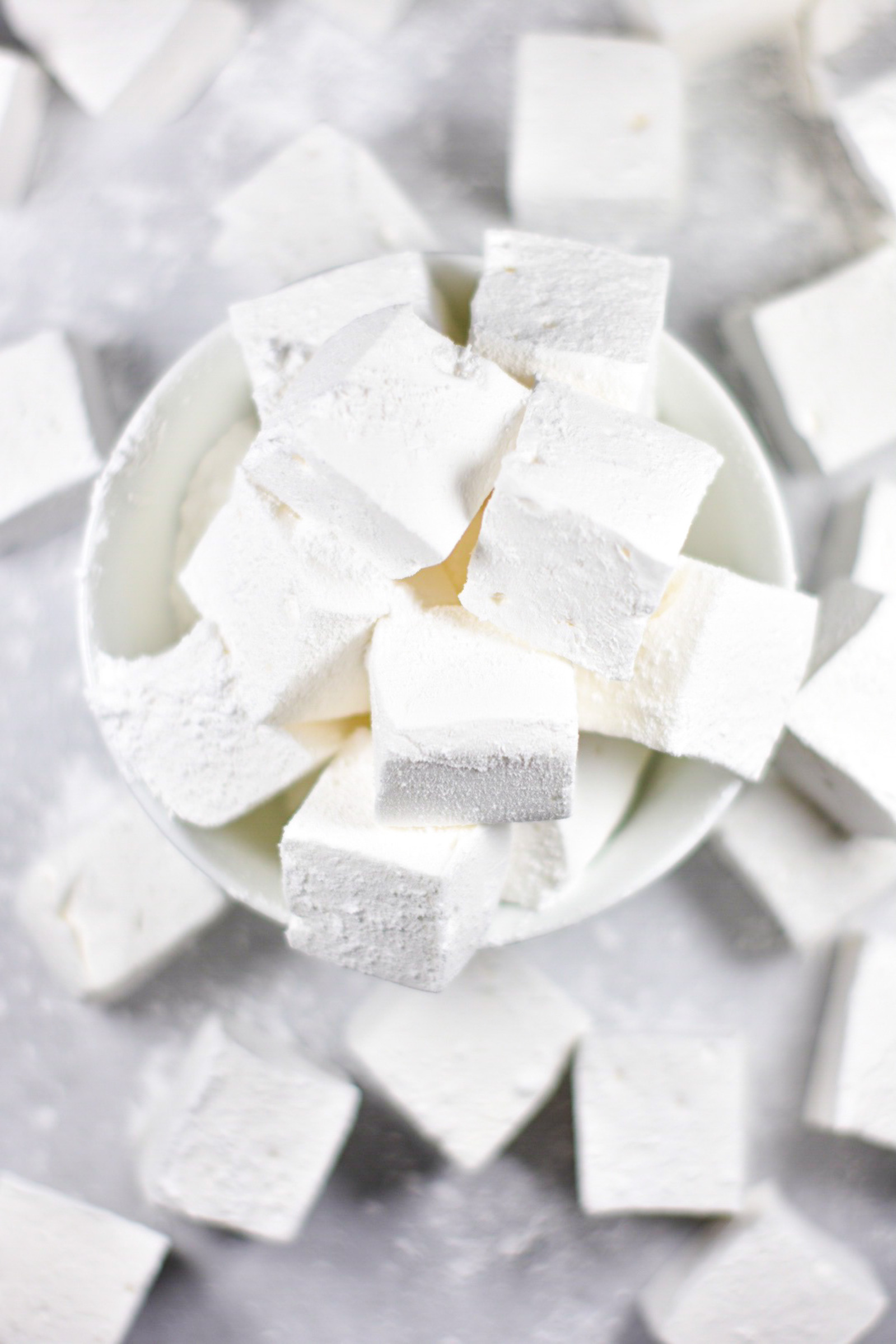This post may contain affiliate links. Please read the disclosure policy to learn more.
Thank you for supporting this blog!
If you’ve found your way to this page, you’re probably here because you want to learn how to convert gelatin sheets to powder. Perhaps you have a recipe you want to make which requires sheets of gelatin, but you only have powder on hand. Or maybe you have plenty of powdered gelatin, and no idea how to make a recipe which calls for leaves.
Or maybe you weren’t aware that gelatin comes in more than one form, or are not even sure what it does!
Well, if you’ve ever eaten a marshmallow, enjoyed a dish of panna cotta at a restaurant, made a batch of Jell-O jigglers, or had one too many Jell-O shots at a college party, you’re already familiar with a setting agent known as gelatin (sometimes spelled gelatine), whether you know it or not.

What is Gelatine (Gelatin)?
Gelatin (or gelatine) is a colorless, odorless, and unflavored ingredient used in professional pastry and confectionery kitchens, as well as by many home cooks. It represents a key component in mirror glazes, mousses, jellies, flans, panna cottas, marshmallows, and other soft-set candies and desserts.
Gelatine comes from animal collagen, most commonly from fish, pigs, and cows. It comes in several forms. The two you’ll commonly see in recipes are sheets (or leaves) or dehydrated powder. Both require soaking prior to use.
After soaking, the substance forms a gel (or “mass”) which acts as a setting agent.
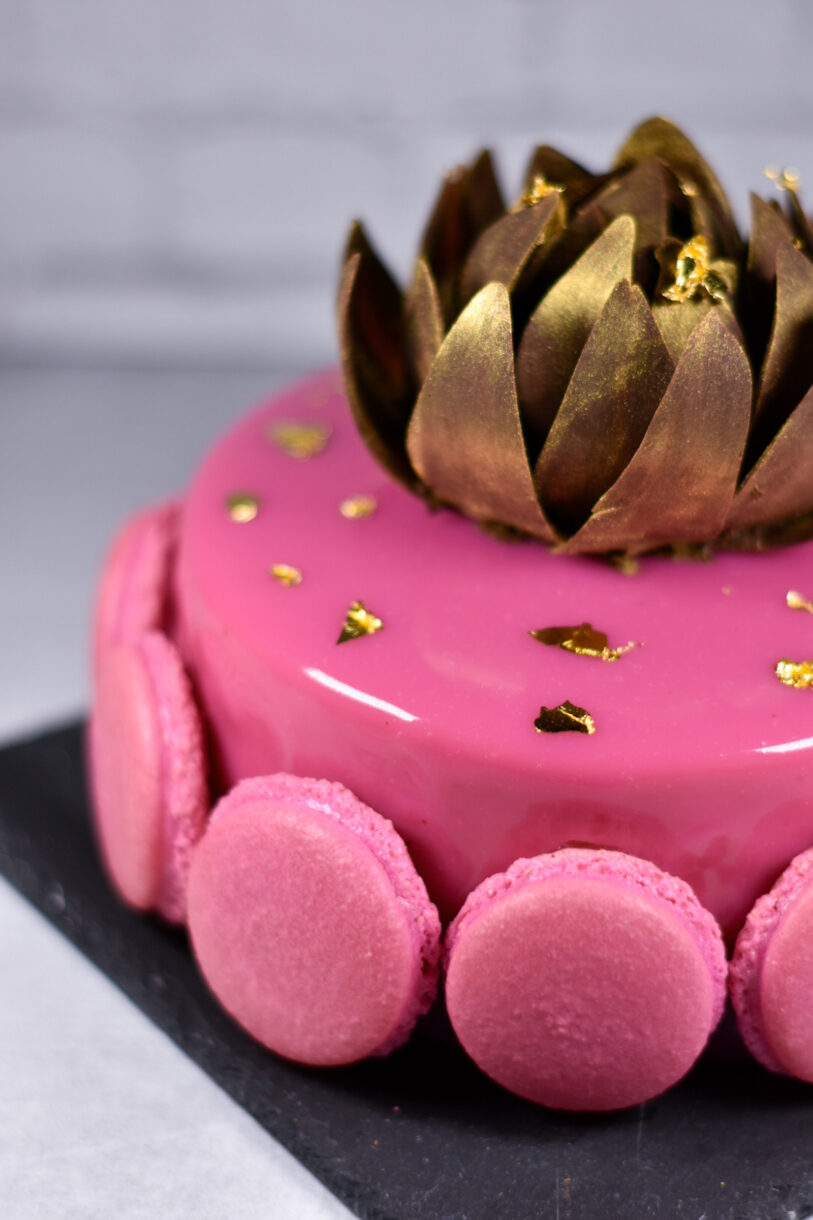
Learning to Use Gelatin Leaves (or Sheets)
Growing up in Pennsylvania, grocery stores only sold the powdered stuff. Packaged in little individual sachets, we’d buy it to make “Knox blox” or Jello molds. But beyond weird jiggly desserts (and in college, Jello shots), nobody seemed to bake with gelatin, or really have much use for it at all.
When I moved to London to attend pastry school at Le Cordon Bleu, I learned about leaf gelatine (a.k.a. gelatine sheets) for the first time. Leaves serve the same purpose as the powdered variety, but they come in different strengths. (Gelatin strengths are also known as “bloom”). I find the leaves easier to transport in my pastry kit, and much easier to use. They’re also less messy.
In the UK, Europe, and other parts of the world, home baking brands like Dr. Oetker produce leaves which are readily available in the baking aisle of most supermarkets. In the US, leaves or sheets are typically only available via Amazon or a bakery supply company. The leaves also cost more, as they aren’t widely used in American home kitchens.

In fact, even large quantities of powdered gelatine aren’t readily available in the US without placing a special order. If you plan to use it often, or are working in large batches. It’s much more economical to order a large tub (I usually buy these tubs from Amazon).
Which Kind of Gelatin Do You Prefer?
These days, I tend to prefer leaves for most of my bakes, especially for mousses and mirror glazes for entremets. However, when I make marshmallows I do like to use powder. For one thing, it’s cheaper. (Which is nice because a pan of marshmallows requires a large quantity—about 20 grams or 2 tablespoons of powder, which is equivalent to 8 sheets of leaf gelatine for a small square pan!) I also make lots of marshmallows,so I go through my supply at a rapid pace!
Depending on your location, you might be familiar with leaves or powder, but maybe not both. In this post, I’ll explore the differences between leaf and powdered gelatine, the proper way to use each type, and how to convert measurements in recipes. I’ve also included a basic marshmallow recipe made with leaves, which can easily be used as a guide for making any of my marshmallow recipes.
Types of Gelatine
There are two types of gelatine: leaves (sometimes referred to as sheets) and powder. Powder tends to be the default for home bakers in the United States, while leaves are the standard in other parts of the world. Both types function in the same way, and both require soaking in water prior to use.
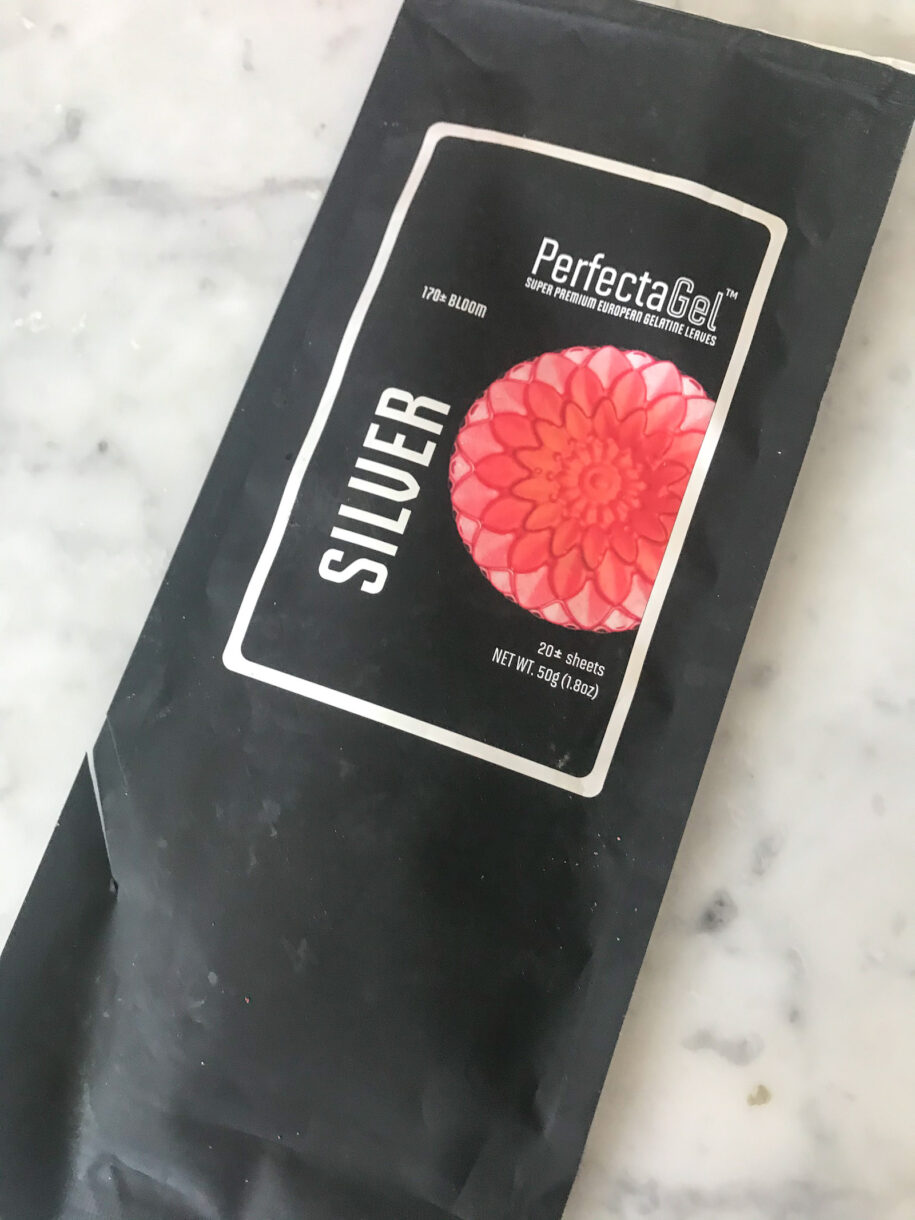

How to Use Leaf Gelatin
First, measure out the amount of gelatine needed for your recipe. Recipes often list a number of sheets, or sometimes include a weight in grams. In the marshmallow recipe below, for example, eight sheets of gelatine are required.
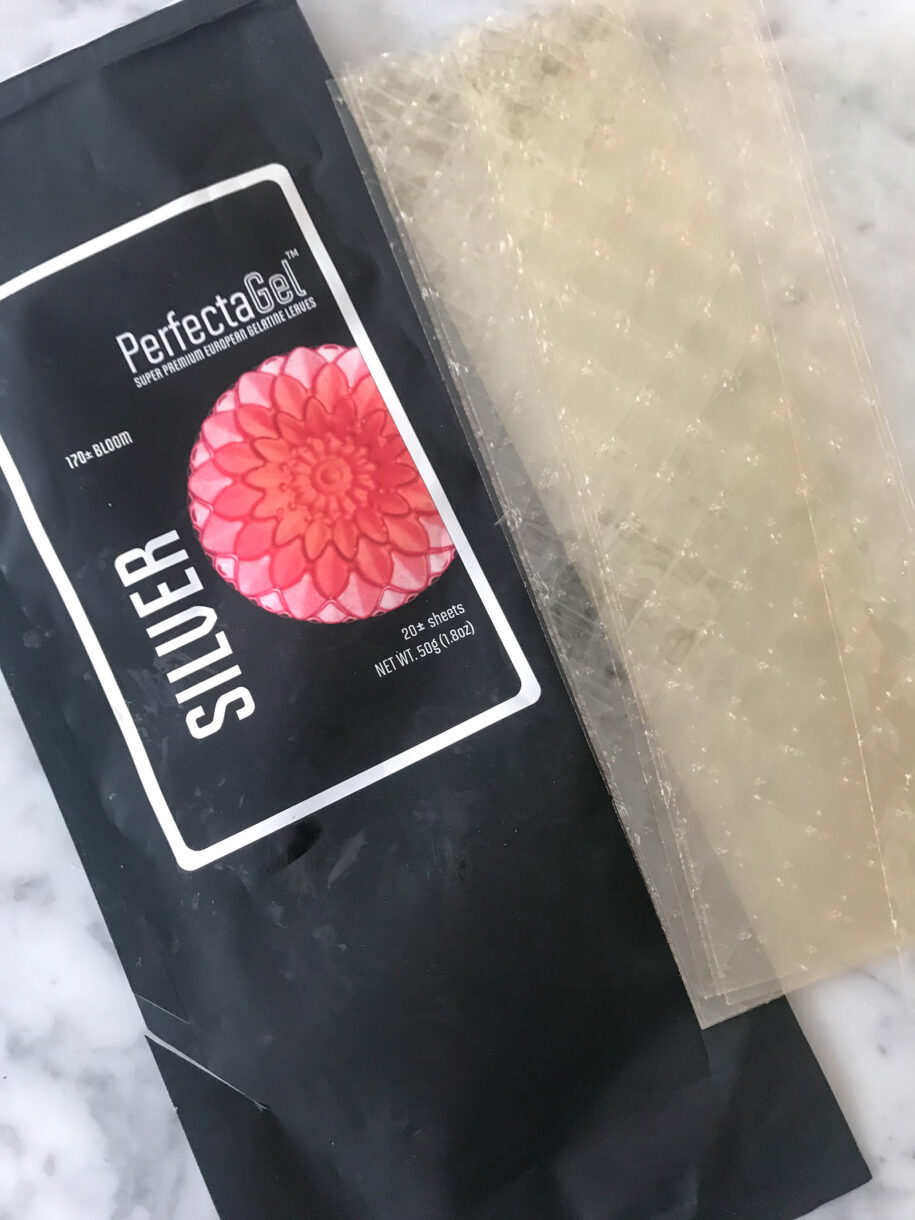
When reading the recipe, be sure to note whether a specific gelatine strength is required. Unlike powdered gelatine, the leaf variety comes in multiple bloom strengths: bronze, silver, gold, and platinum. Silver (usually around 160-180 bloom) is the most commonly used gelatine strength, and what I’ll usually default to unless the recipe specifies otherwise.
Before using the gelatine, you’ll need to soak your sheets in water. Be sure to use cold water for soaking. Warm or hot water will not allow the gelatine to bloom properly, and it might even cause the sheets to dissolve.
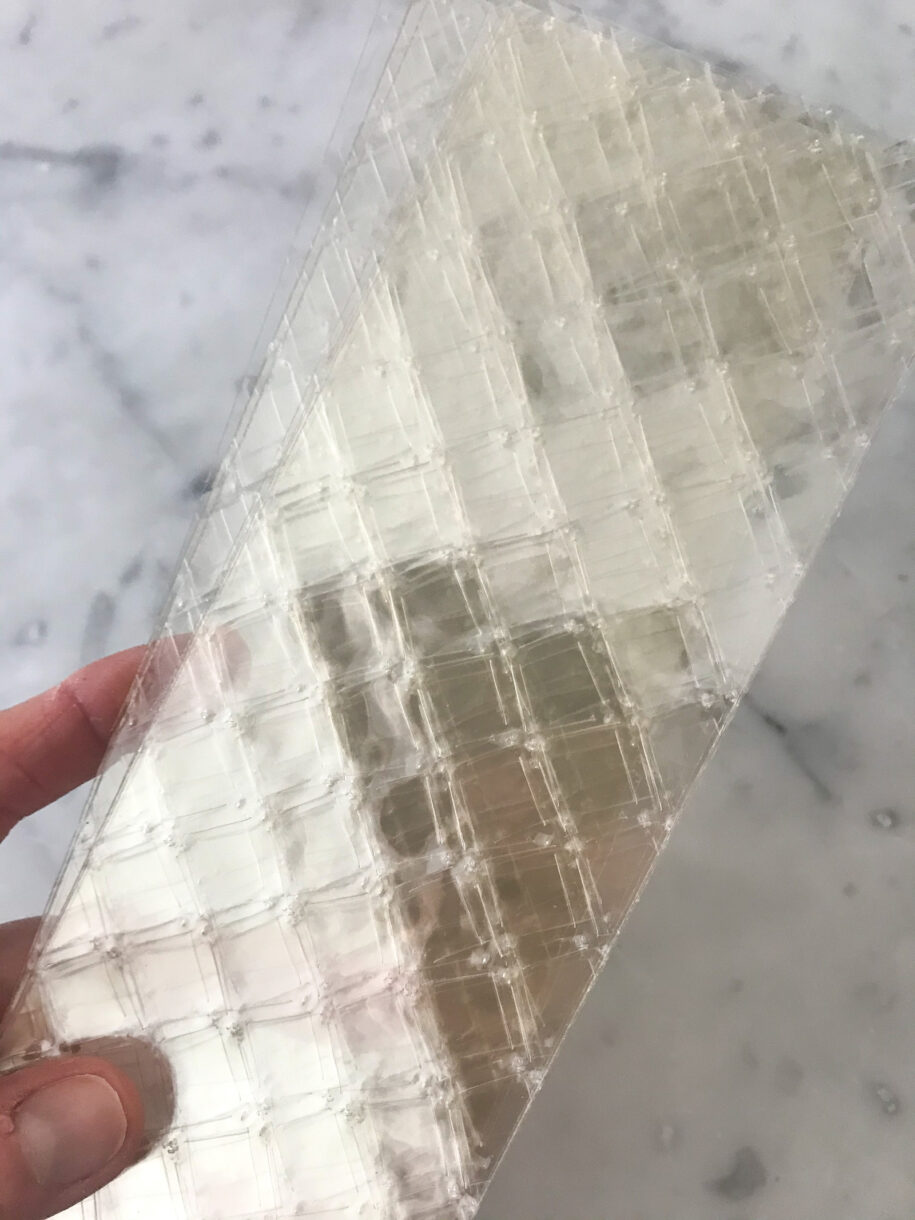
I find it helpful to cut the sheets into smaller pieces. Otherwise, they can be difficult to soak unless you have a very large bowl. Also, double check to make sure that none of the sheets are sticking together, and that they’re all completely submerged in the cold water.

After soaking your sheets (usually for about 3-4 minutes or so, although the more sheets you’re using, the longer they’ll take to soak) use your hands to remove the mass from the water. Then, squeeze out any excess liquid.
And that’s it! Your gelatine is ready to use, and you can proceed with the recipe as written. Note that the recipe will instruct you to add the mass to hot liquid (in the marshmallow recipe below, you’ll cook your sugar mixture to 116° C / 240° F before combining it with the gelatine). The mass will not dissolve in cold liquid, so pay careful attention to your temperatures.
How to Use Powdered Gelatin
Unlike leaf gelatine, the powdered variety comes in only one strength. It is typically packaged in boxes of small individual packets, or in plastic tubs such as this:
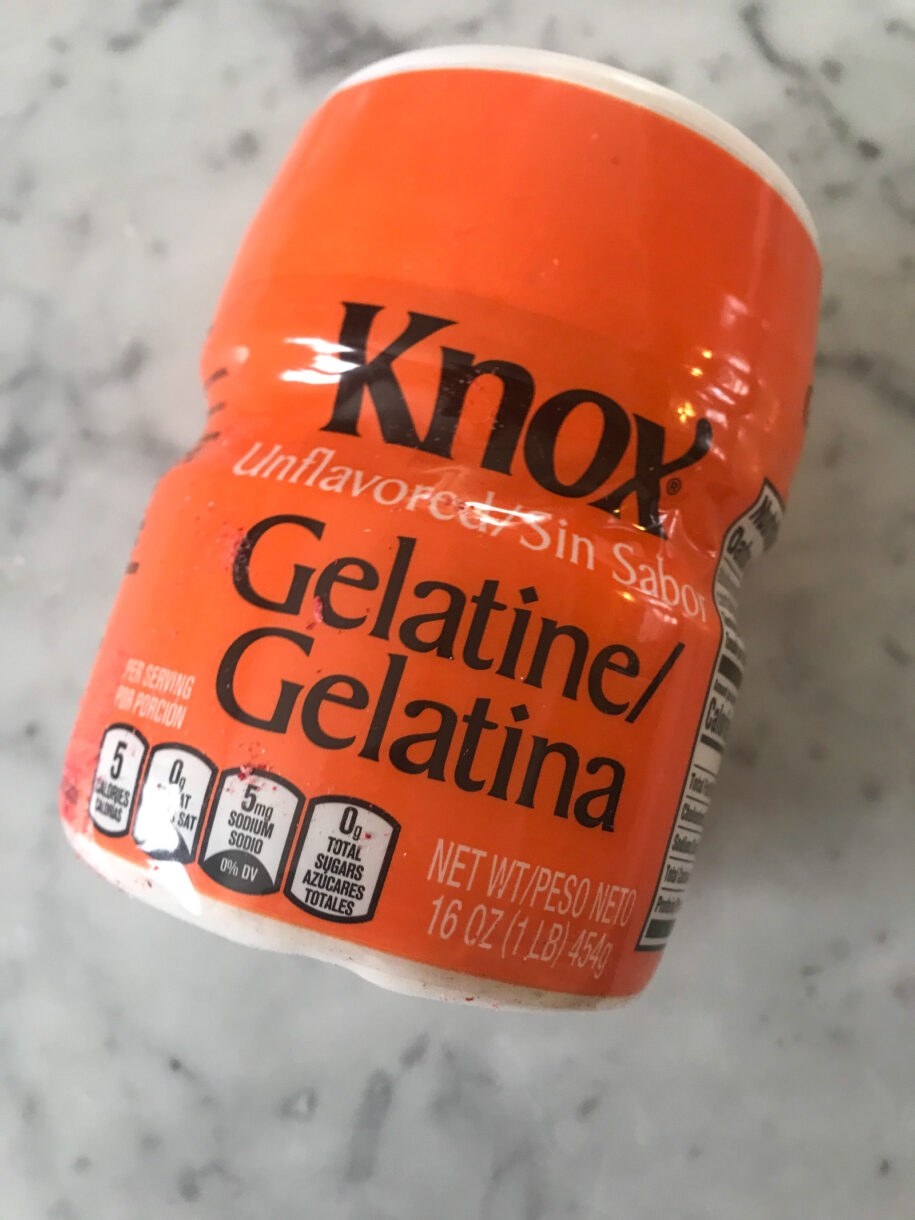
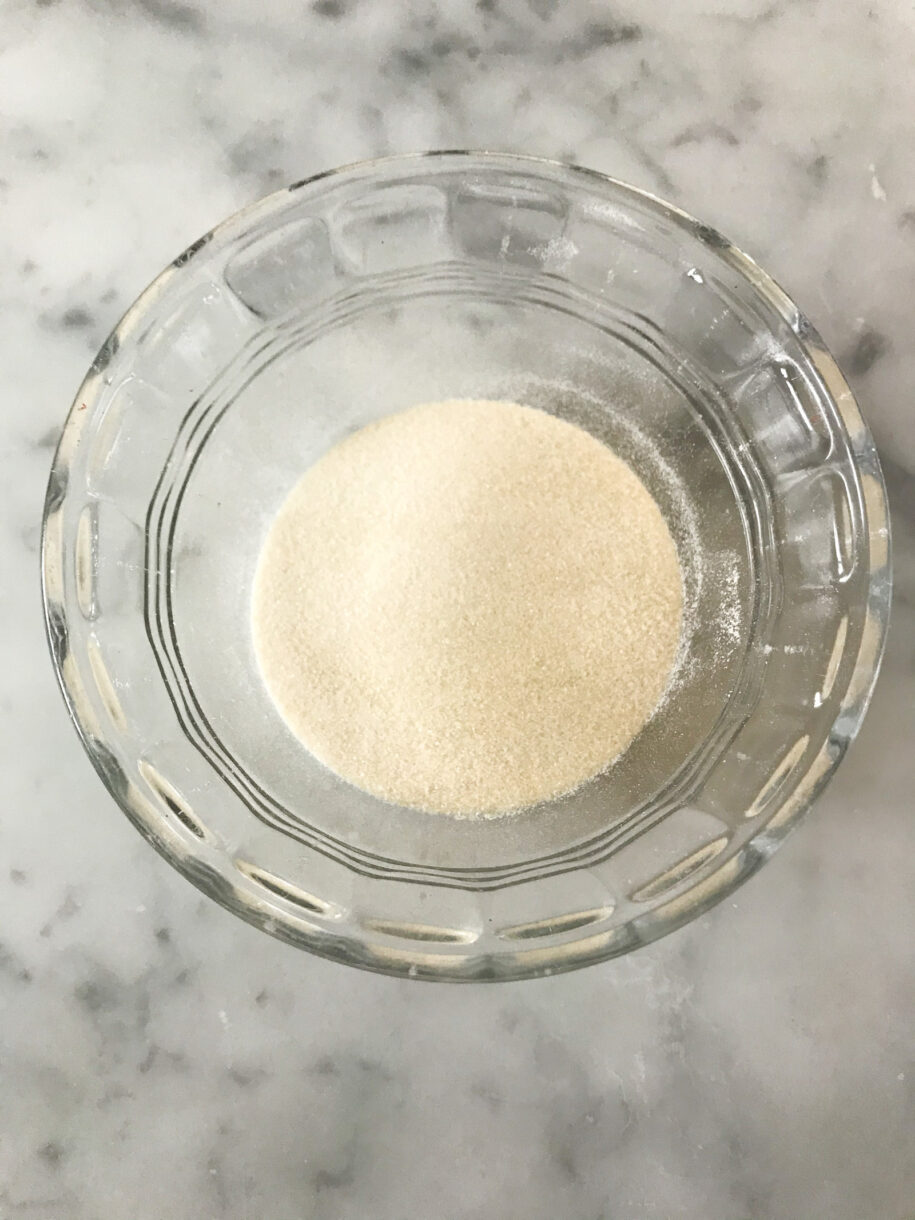
Like sheets, the powder must be soaked in water prior to use, but the methods are somewhat different. When using powdered gelatine, a recipe will specify the amount of water needed. (For the vanilla marshmallows below, you’ll use 105 grams, or about 1/2 cup, of cold water). Generally, you’ll be instructed to add the water to a bowl or saucepan, then sprinkle the powder on top and wait for a few minutes until the water has absorbed.
Unlike leaves, powdered gelatine does not need to be drained after soaking. Instead, the liquid actually absorbs into the powder to create your gelatine mass.
How to Convert Gelatin Sheets to Powder
The exact conversion between leaves and powder will depend on the strength and size of the sheets of leaf gelatine used, as well as the brand of powder. However, the general consensus is that 1 tablespoon of powder = 3-4 sheets of gelatine (or that 1 teaspoon = 1-2 leaves). Powdered Knox gelatine (the brand most commonly available in the US) is thought to have a bloom strength of around 200-225 bloom.
In the marshmallow recipe below, I’ve used 8 sheets of PerfectaGel silver gelatine (170 bloom) to replace 20 grams (2 tablespoons) of Knox powder.
Gelatin Allergens and Dietary Restrictions
No matter which kind you choose, gelatine is a collagen-based product and is therefore not suitable for vegans or vegetarians. It is also not suitable for anyone with religious dietary restrictions related to the consumption of beef or pork.
The exact collagen source depends on the brand, but most commercial products are derived from pork, veal, or beef. Fish gelatine is also widely available. Keep in mind that if using a fish version, you must also include an allergen warning for those allergic to fish/shellfish.
As a substitute, vegan bakers often use agar agar as a gelling agent. Agar agar possesses similar setting properties to gelatine, but derives from seaweed rather than animals, making it suitable for vegetarians. Pectin, a fruit-based thickener often found in jams and in jellied candies like pâte de fruits, can also serve as a replacement in some recipes.

Making Marshmallows with Gelatin Leaves
The recipe below utilizes leaves instead of powder, and can be referenced as a guide for making any of the marshmallow recipes on this site. It’s really just about a few simple substitutions, and the method in which the gelatine is soaked. These marshmallows taste exactly the same no matter which kind of gelatine you use!
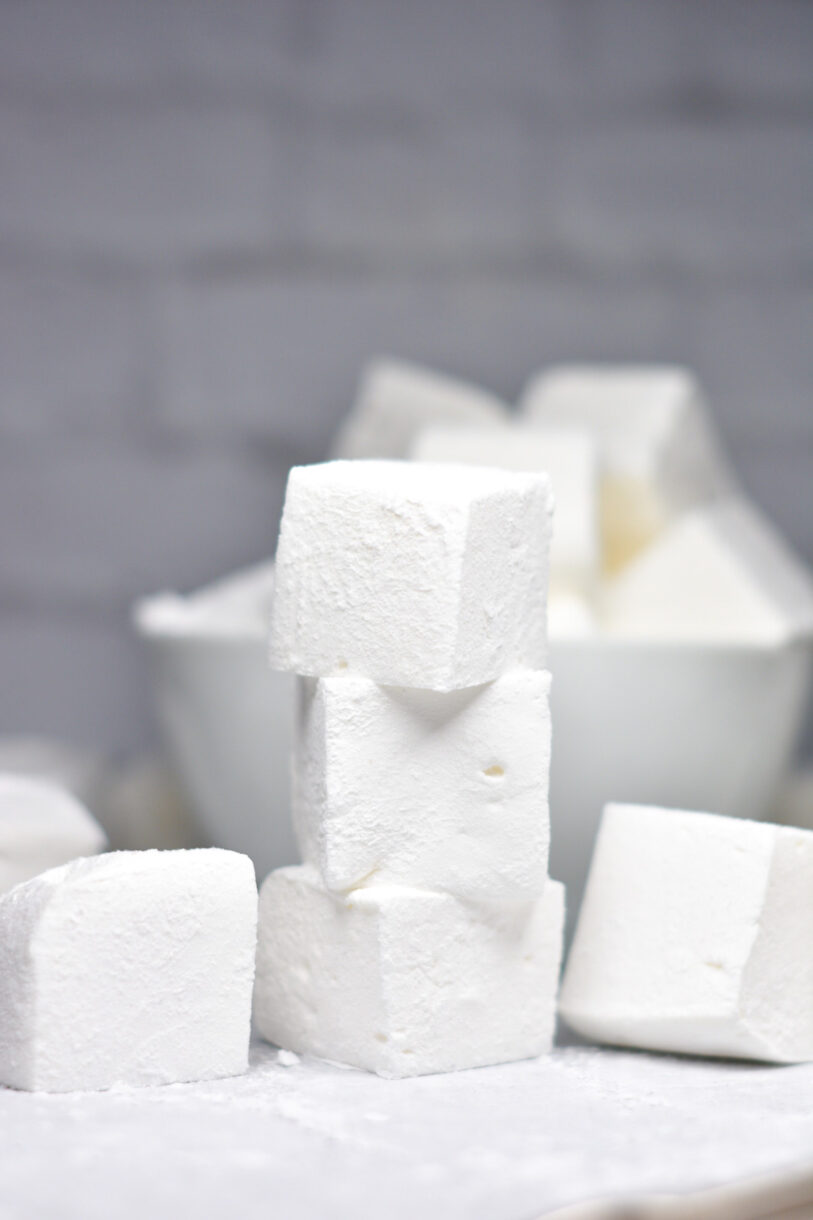

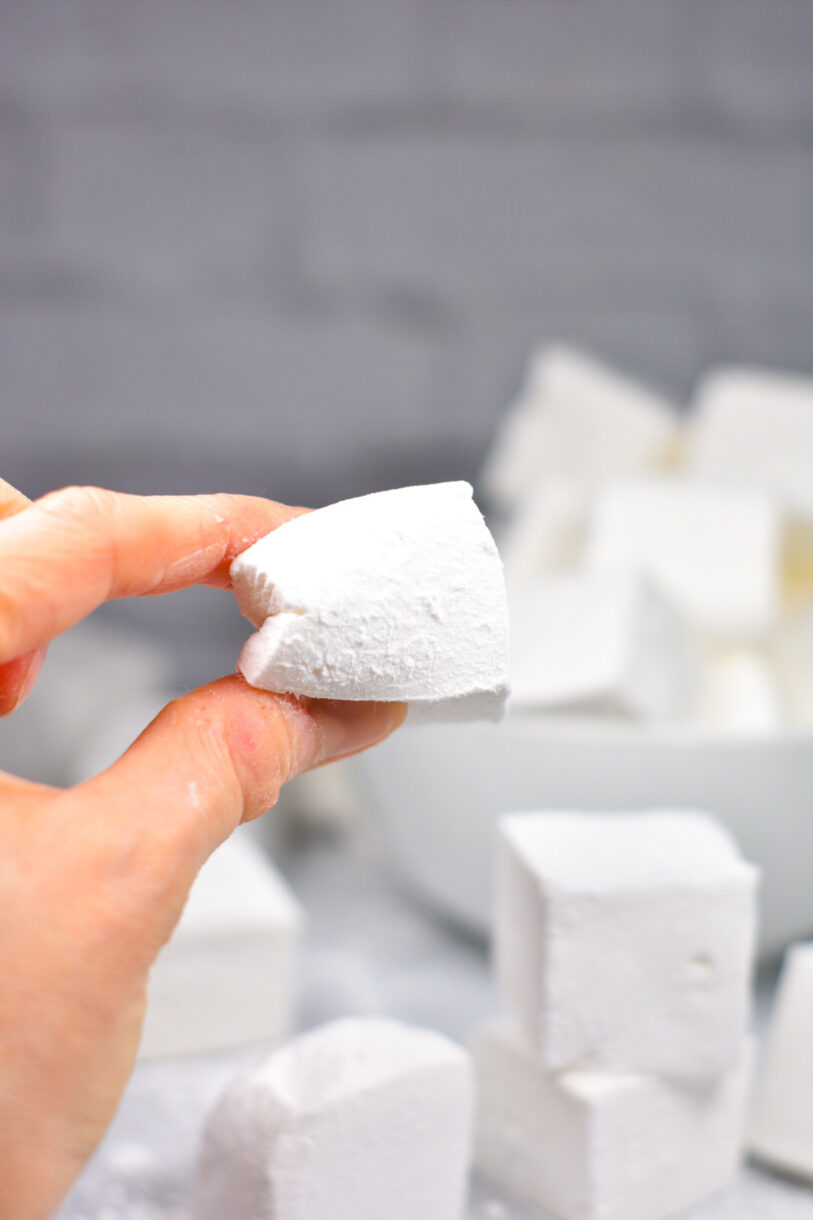
Other marshmallow recipes you might enjoy:
Strawberry marshmallows
Prosecco marshmallows
Red wine marshmallows
If you make these, or any of my recipes, don’t forget to tag me @bastecutfold or use the hashtag #bastecutfold on Instagram. I always love to see what you’re making!
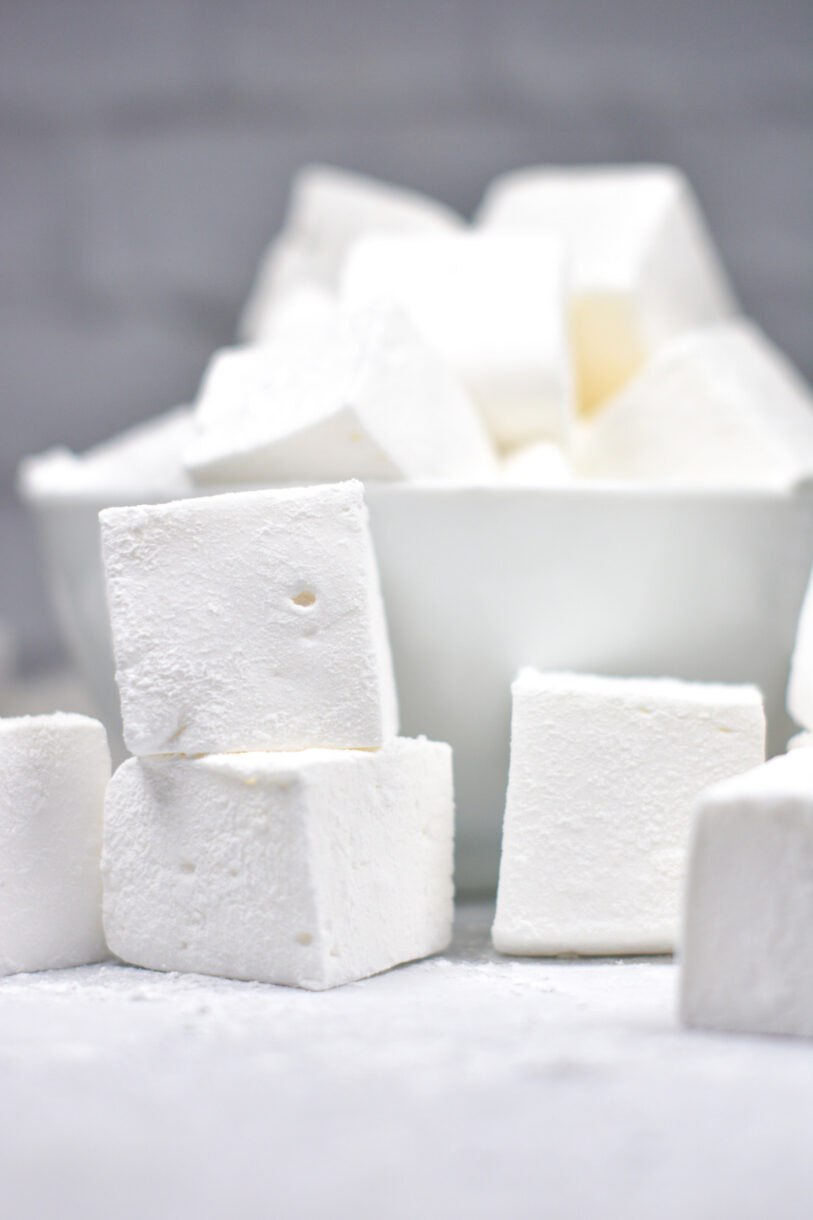

Basic Vanilla Marshmallows
- Total Time: 30 minutes (+ overnight resting time)
- Yield: 36 marshmallows 1x
Description
A classic vanilla bean marshmallow made with leaf gelatine.
Ingredients
105 milliliters water (1/2 cup), plus more for soaking gelatine
8 sheets silver grade gelatine
400 grams granulated sugar (2 cups)
200 grams corn syrup or liquid glucose (1/2 cup)
1/4 teaspoon salt
1 teaspoon vanilla bean paste
Canola oil or nonstick cooking spray, for greasing tin and knife
Coating:
50 grams potato starch* (1/3 cup)
50 grams confectioner’s sugar (1/3 cup)
Instructions
Marshmallow Slab:
Line an 8×8-inch / 20 x 20-centimeter square tin with parchment, and coat generously with oil. (See this recipe for the best lining technique!) Set aside until ready to use.
Fill a bowl with COLD water. Add leaf gelatine, and set aside to soak.***
Meanwhile combine sugar, corn syrup or liquid glucose, 105 milliliters water, and salt in a large saucepan. Bring mixture to a boil and boil, without stirring, until syrup reaches 240° F / 116° C on a candy thermometer.
When sugar mixture is near temperature, remove the soaked gelatine from the water and squeeze it to drain any excess water. Add gelatine mass to a large mixing bowl (if using a hand mixer), or the bowl of a stand mixer.
Carefully pour hot syrup into gelatine bowl. Mix on high speed for 2-3 minutes, until mixture begins to thicken. Add vanilla bean paste and continue to mix on high speed until very thick, about 8-9 minutes more.
Using an oiled spatula, scrape marshmallow mixture into prepared tin. Loosely cover with a well-oiled sheet of aluminum foil. Allow to set until firm, at least 4 hours or overnight.
Cutting and Coating:
In a small bowl, combine potato starch and icing sugar.
Cover a large chopping board with a sheet of parchment, and dust generously with starch-sugar mixture.
Turn marshmallow slab out onto dusted surface. Sift top of slab with more of the starch-sugar mixture.
Use a well-oiled knife to cut the slab into squares. I like to do six rows of six, which makes 36 generously-sized marshmallows.
Toss cut marshmallows in additional starch-sugar mixture, making sure all sides are coated.
Marshmallows will keep well for several weeks when stored in an airtight container at room temperature.
Notes
*If you can’t find potato starch, cornstarch/cornflour can be substituted here.
**Also known as confectioner’s sugar, or powdered sugar.
***I find it helpful to cut the sheets of leaf gelatine into small pieces, as they can otherwise be difficult to soak unless you have a very large bowl. Check to make sure that none of the sheets are sticking together, and that they’re all completely submerged in the cold water.
- Category: Candy and Confectionery
- Method: Stovetop
- Cuisine: Sweets
